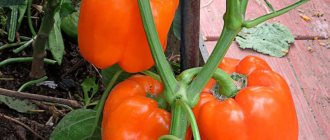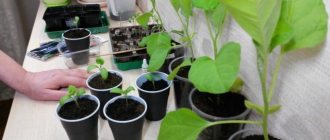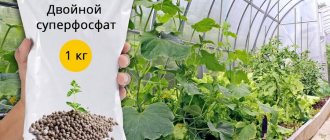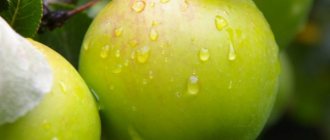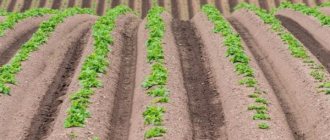History of the variety's creation
This white hybrid was bred by specialists from the famous Dutch agricultural company at the beginning of this century. A patent was issued for the Bibo f1 eggplant in this country. The hybrid was included in the Russian State Register in 2008.
Bibo eggplant is recommended for cultivation in most Russian regions. In the south of Russia, this hybrid variety can be planted directly in open ground, and in regions with colder climates it is better to plant it in film greenhouses or grow it in greenhouse conditions.
Photo of eggplant Bibo F1
How to grow seedlings yourself
For planting plants, it is recommended to use only seeds purchased from trusted sellers or specialized stores. In southern regions with warmer climates, Bibo eggplant seeds are sometimes immediately sown in open soil, but for the rest of the area it is best to pre-grow seedlings.
In open ground, planting material may be negatively affected by spring frosts, which will negatively affect germination.
Time for sowing
You need to sow seeds for seedlings so that by the time they are transplanted to a permanent place of cultivation, several green leaves have time to grow on it, but the sprouts are not too large.
Accordingly, the cultivation of Bibo eggplant seedlings begins at the end of February or at the beginning of March. In this case, young shoots can be planted in open ground around the end of April or beginning of May, when consistently warm weather sets in and the likelihood of night frosts disappears.
Did you know? People began to eat eggplant only in the 18th century.
—
before this time it was used for decorative and medicinal purposes.
The soil
In order for Bibo eggplant seeds to receive all the necessary beneficial elements for growth, it is recommended to plant them in nutritious and loose soil.
You can buy it in specialized stores or prepare it yourself from the following components:
- chernozem - 50%;
- peat - 25%;
- sand - 25%.
Before planting seeds, it is recommended to thoroughly bake the soil in the oven for disinfection. Then the containers for seedlings are filled with this mixture and the soil is watered so that it is saturated with moisture and settles.
Growing container
Seedlings of the Bibo variety are grown in small individual containers filled with soil. It is not recommended to use a common container for growing several seedlings in it, since in this case the young plants will need to be picked, and this procedure is not well tolerated by eggplants of the specified variety.
If you still grow sprouts in one common box, then they must be picked very carefully, preserving the earthen lump formed around the roots of the sprout.
As an individual container for sprouts you can use:
- peat cups;
- small wooden boxes;
- small plastic containers;
- "diapers" from plastic bags.
In this case, the volume of the container for Bibo eggplant seedlings must be at least 400 ml.
Seed preparation
Before sowing seeds for seedlings, you should carefully read the instructions on the package. If it indicates that the seed has undergone the necessary processing, then you can immediately begin sowing it. But it also happens that purchased seeds are not processed by the manufacturer, so you need to prepare them yourself.
The process of preparing Bibo eggplant seeds for planting consists of the following important steps:
- Quality checking. Planting material is placed in a glass of clean water. After 20–25 minutes, low-quality seeds float to the surface - they need to be discarded.
- Sterilization. The seeds are immersed in a 1% solution of potassium permanganate for 15 minutes to get rid of possible infections. After sterilization, the seeds are washed well with water.
- Growth stimulator. The germination rate of Bibo eggplant seeds is very high, so this preparation step is not necessary. But if you wish, you can soak the planting material in a growth stimulant solution for 10 hours so that it sprouts faster.
- Drying. After all the described procedures, the planting material is laid out on a paper napkin and dried for 1–2 hours at room temperature.
Sowing seeds
After all procedures for preparing the soil and planting material have been completed, you can begin planting the seeds. This process does not require special knowledge; it is enough to follow standard recommendations.
Important! You need to water the planted seeds with a small amount of water, gently spraying it over the surface of the soil.
Step-by-step instructions for sowing Bibo eggplant seeds for seedlings are presented below:
- Make small depressions in the soil. If one common box is selected for sowing seedlings, then the distance between adjacent recesses should be at least 5 cm.
- Place the seeds 1.5–2 cm into the prepared holes.
- Sprinkle the planting material with loose soil.
- Cover the container with seeds with film and place in a well-lit, warm place (at least +22°C).
- If necessary, lightly irrigate the soil in containers with planted seeds. In such conditions, green shoots appear in 1–1.5 weeks.
Seedling care
Typically, sprouts from seeds appear in early March, when it is still cold outside and daylight hours are not long enough, so young seedlings need to be provided with good lighting and grown in a warm room.
The main features of caring for Bibo eggplant seedlings are presented below:
- after the bulk of the seeds have sprouted, the room with the seedlings needs to be maintained at a temperature of about +18 °C for several days. The seedlings are then grown at normal room temperature;
- for better growth, seedlings are placed in a well-lit place, and when it gets dark outside, they turn on phytolamps for artificial lighting;
- You cannot place containers with seedlings in a draft - this will destroy the young shoots;
- if the seeds were planted in a common container, then after a pair of leaves appear on the sprouts, the seedlings are picked into individual containers, while maintaining an earthen ball around the roots;
- for normal growth, after 2-3 green leaves appear on the sprouts, nitrogen-containing and potassium fertilizers are applied to stimulate the growth of green mass;
- 7–12 days before the planned replanting, fertilizing consisting of phosphorus and potassium is once again applied to the open ground;
- Watering the sprouts is carried out only at the root every 5–7 days. For the procedure, warm water with a temperature of +22…+24°C is used.
Find out also what hybrids of white eggplants there are.
Hardening of seedlings
In order for Bibo eggplant seedlings to better tolerate transplantation into open ground, it is recommended to harden off young plants. This procedure should be started about a week before the planned planting of the sprouts in a permanent place, when the seedlings have already grown well and become stronger.
For hardening, containers with seedlings are taken outside. In the first days, you should leave it outdoors for no more than 20–30 minutes. This time is gradually increased, bringing it to several hours by the end of the week.
Eggplant Bibo F1: variety description
Bibo eggplant is classified as an early-ripening variety - less than 3 months pass from the moment of germination of planting material to the harvest of ripe products.
In the case of growing the variety in seedlings, ripe eggplants are collected 2 months after the seedlings are planted in garden beds or in a greenhouse.
Description of eggplant Bibo F1 - video
The main positive qualities of the hybrid are:
- the possibility of active growth and ripening of fruits in extreme climatic conditions;
- high resistance to major diseases characteristic of other varieties of this vegetable crop, as well as to attacks by insect pests.
Bibo eggplant bushes
– medium height, quite compact, with short internodes, so this variety can form a fairly large number of ovaries.
The shoots are strong and strong, can reach a height of 0.9 m, they are actively growing, foliage is average, pubescence is weak, color is soft purple.
Bibo eggplant harvest photo
The foliage is small in size, quite wide, the leaf plates are rough, the edges are wavy, the color is rich, emerald green.
On a note!
The calyxes of ripe Bibo eggplants have sharp spines, making the fruit difficult to harvest.
The shape of the fruit is cylindrical, the skin is quite dense, thin, glossy, with an original white color. Ripe eggplants are approximately the same size, which is very important if vegetable growers grow this variety for further sale of the fruit.
The average weight of ripe Bibo eggplants is about 350 g, but the first fruits can grow up to 450-500 g.
Up to 15 ovaries are usually formed on one bush. Size of a ripe fruit: length – 16-17 cm, diameter – 7 cm.
The pulp of ripened fruits is compacted, tender, the color is white with a greenish tint.
The fruits lack solanine, which usually imparts bitterness to ripe eggplants, so Bibo eggplant products taste more pleasant.
The harvested crop can be transported to any distance; it can be stored in the refrigerator for quite a long time.
Selection and botanical description of the culture
The described variety is a hybrid variety and was obtained at the beginning of the 21st century in Holland. A team of breeders from MONSANTO HOLLAND BV worked on developing the hybrid.
Did you know? The Golden Eggs variety is the only type of eggplant that is grown exclusively as an ornamental houseplant.
They wanted to get a new variety of eggplant that combines the good taste of vegetables, early ripening of the crop and the ability to adapt to unfavorable climatic conditions. In Russia, Bibo eggplants began to be grown in 2008.
The main characteristics of the plant are presented below:
- The bushes have a small height - up to 85 cm. They are moderately spreading and consist of several purple stems covered with fluffy leaves.
- The leaves of the plant are small and have slightly wavy edges. Painted green.
- On the calyxes near the base of the fruit there are frequent short spines.
- The fruits have an elongated oval shape. The outside of the vegetables is covered with white matte skin.
- The length of the fruit is 18–20 cm, and the diameter can reach 8 cm.
- The variety is early ripening, harvesting can be done 85–90 days after germination of the seed material.
- The average fruit weight is about 210–300 g; all eggplants on a bush are approximately the same size.
- The Bibo variety is characterized by high germination. Productivity can reach 4.8 kg per 1 sq. m.
- The pulp of the vegetable is white and juicy. It tastes great without any unpleasant bitterness. Unlike other varieties, vegetables of this variety do not contain poisonous solanine.
- Bibo eggplants are resistant to fusarium and tobacco mosaic virus, but can be attacked by the Colorado potato beetle.
Main characteristics
This variety is deservedly popular among Russian vegetable growers, who have already left many positive reviews about the Bibo hybrid on the gardeners’ forum.
Comparison of the grown harvest of different eggplant varieties - video
This eggplant has a well-developed root system, so Bibo tolerates periods of drought well. However, a decrease in air temperature during the period of active ripening of fruits negatively affects their development, as a result, productivity suffers.
Productivity
Fruiting of Bibo eggplant is extended over time
– the first fruits are harvested in the second ten days of August, and the last ones ripen around mid-September. Ripe eggplants, which are medium in size and white in color, should be collected from the bushes.
It is important to know!
As the fruits outgrow, the flesh of the Bibo eggplant acquires a bitter taste, and the seeds become coarser.
At this time, the pulp of the fruit is tender, and the seed material is small and practically not felt when eating.
Review of white eggplants - video
Usually the harvest is harvested at least once a week, thanks to which new ovaries appear on the bushes faster.
Important!
The fruits are not picked from the bushes along with the stalk, but are carefully trimmed with garden shears or pruning shears at a distance of 4.5 cm from the base of the eggplant.
At least 5 kg of ripe fruits are collected from one square of area.
You should not thicken the plantings of this vegetable crop - if the plants are planted too densely, the size of the fruits will be smaller, and the eggplants themselves will become distorted.
Often, planting density is the reason for the complete absence of fruiting in a given vegetable crop.
Area of application of fruits
Eggplant fruits contain a large number of macro- and microelements, a number of vitamins and some other nutrients that are very beneficial for the human body.
Therefore, nutritionists recommend including this vegetable in the daily menu even for healthy people.
Bibo eggplants on a bush - photo
Thanks to the excellent taste of Bibo eggplant, it can be eaten fresh.
This fruit is also actively used by housewives in cooking, it is cooked with other vegetables in the oven or baked on the grill, used to prepare various snacks, a side dish for meat or fish, preserved for the winter - they make caviar, pickled with other vegetables, frozen for the winter.
Harvesting and application
From emergence to harvest, 100–120 days pass. The crop produces its first fruits in August–September.
Important! The strong stem of the eggplant is not torn off, but cut off with pruning shears at a distance of 4-5 cm from the base of the fruit.
Bibo fruits contain potassium, calcium, phosphorus and iron, so they are useful for preventing heart disease, anemia, and strengthening the skeletal system.
Eggplants are widely used in home cooking: cooked on the grill, in the oven. They are used to make casseroles, side dishes, snacks and winter preparations.
Diseases and pests
Among the main diseases, seedlings or adult plants can be affected by blackleg, which usually occurs when there is an excess of moisture in the soil. The main symptom of the disease is the appearance of a dark ring at the base of the trunk.
Subsequently, the plant dies. The main prevention of this disease is compliance with the irrigation regime and air humidity.
Photo of a bag of Bibo eggplant seeds with a description from the manufacturer
In the second half of summer, nightshade vegetable crops may suffer from late blight
, which develops due to high humidity and sharp changes in day and night temperatures. Treatment of bushes with Bordeaux mixture or copper sulfate can combat the disease.
Among insect pests, Bibo eggplant can be damaged by Colorado potato beetles and slugs.
. The Colorado potato beetle eats the foliage, as a result the plants gradually die. They are usually collected from plants by hand and burned.
When to plant seedlings?
When the soil warms up well, plant the Bibo F1 eggplant. Planting time: 2-4 weeks of May (weather conditions permitting).
Important! If after planting in the garden the air temperature drops sharply below 15°C, then there is a risk of flowers and buds falling off.
Seedlings are planted in rows. The distance between neighboring plants should be up to 60 cm, between rows - 55-75 cm. Each plant is placed in a dug and well-moistened hole. Having taken the seedlings out of the cup, they place them in the hole without shaking off the soil from the roots - this can damage them and the seedlings will not be accepted.
Positive qualities of the variety
The main advantages of the Bibo eggplant variety include:
- ultra-early fruit ripening;
- versatility of the harvested crop;
- excellent taste of Bibo eggplant;
- there is no bitterness in the pulp;
- original color of ripe fruits;
- resistance to periods of heat and cold;
- good yield;
- resistance to most diseases, in particular to fusarium and tobacco mosaic;
- the Bibo variety can be grown in garden beds and in greenhouse conditions;
- the collected fruits can be transported to any distance and stored for a long time.
The main disadvantages of this hybrid:
- shoots require mandatory garter;
- Sharp thorns grow on the calyxes of Bibo eggplant fruits, making harvesting difficult;
- This eggplant is a hybrid, so it will not be possible to collect seeds for further planting.
Advantages and disadvantages of white eggplant
Bibo eggplant is considered the best white-fruited hybrid. The variety is known for the following advantages:
- grows quickly;
- resistant to diseases;
- does not shed the ovary under stress and temperature changes;
- bears fruit for a long time and abundantly;
- due to the light color, the fruits are less likely to bake in the sun;
- transportable;
- the fruit is covered with a thin and delicate skin;
- does not require soaking before cooking;
- decorates the garden.
The fruits are not bitter even when raw, but even more so when cooked, which is why Bibo is sometimes called dessert eggplant. Although, if you let the vegetable overripe on the bush, a slight bitterness will appear.
Rusty spots on the fruit are signs of overripe white eggplants
The disadvantage of the hybrid is the expensive seeds that will have to be purchased annually. Gardeners note other disadvantages:
- bushes need garter;
- when collecting seeds, the characteristics of the variety are not preserved;
- Sharp spines form on the stalk.
Take care of your hands: there are thorns on the stalk of Bibo F1 ovaries
Thorns on the stems, calyxes and leaves of some eggplant varieties are a manifestation of the genes of distant ancestors. In this way the plant was protected from caterpillars.
Bibo eggplant: growing and planting
Since this plant is a hybrid, seeds must be purchased annually in specialized stores.
Planting seedlings
Bibo eggplant seeds should be sown for seedlings in the second ten days of February.
They have already completed all the pre-sowing preparations, so at home all that remains is to soak the Bibo eggplant seeds for germination for several days, wrapping it in damp material.
On a note!
It is better to purchase soil for planting seedlings in specialized stores - a special soil mixture for growing vegetable seedlings. This substrate is fertile and loose; eggplant seeds grow quickly in such soil.
Before sprouts appear, the soil should be watered with a spray bottle. Typically, shoots appear 10-12 days after sowing the seed.
The air temperature in the room where seedlings are grown must be maintained in the range of 21-24 degrees Celsius. When the plants have at least 2-3 true leaves, they should be picked into separate containers.
Planting Eggplants in Open Ground - video
But vegetable growers know that this vegetable crop does not like transplants, because during this procedure the delicate root system of eggplant seedlings is often damaged.
Therefore, when growing seedlings, vegetable growers often immediately plant the plants in separate cups to avoid the picking procedure.
Description and characteristics of the variety
- Bibo eggplant is a hybrid, not a variety. Seeds must be purchased each time from a specialized store.
- Early ripening. The fruits reach technical maturity 83-91 days after seed germination.
- Suitable for growing in open and closed ground in any region of Russia.
- Resistant to adverse weather conditions. Lowering the temperature has little effect on the number of ovaries and fruit ripening.
- Semi-spreading bushes reach a height of 80 -90 cm.
- Has a powerful root system.
- The peduncles are not thick, lilac in color with slight pubescence.
- The leaves are green, medium-sized, with veins and wavy edges.
- The flowers are purple, small, arranged solitary. One bush bears 12-15 fruits of the same size.
- Short internodes. Calyxes with small spines.
- High yield. From one square meter you can harvest approximately 4.8-5.2 kg of vegetables. The main thing is to follow the rules of agricultural technology, since dense planting reduces the yield.
- Resistant to nightshade diseases and pests. However, experienced gardeners recommend taking preventive measures.
Further care for Bibo eggplants
In the process of care, it is necessary to regularly water the plants, apply fertilizing, loosen and remove weeds, and also periodically treat the bushes against diseases.
How to water eggplants
During the growing season, short periods of drought are acceptable, but from the moment of budding until the harvest of ripe fruits, the soil in the beds should be moist all the time. Therefore, from the beginning of flowering, eggplants are watered 2-3 times a week.
Important!
During hot periods, the amount of watering should be increased.
After watering, the root zone is loosened, and you need to be careful not to damage the root system of the plants. During loosening, all weeds are removed at the same time.
Although Bibo eggplant bushes are not very tall, from the moment the ovaries appear, all shoots must be tied to strong supports so that in the future the stems do not break off under the weight of ripening fruits.
Feeding eggplants: secrets of productivity
Feeding eggplant bushes
You need to feed eggplants according to the following scheme:
- a couple of weeks after transplantation - with a solution of nitrogen fertilizers;
- during the flowering period, eggplants are fed with complex mineral fertilizers;
- during fruit ripening - a mixture of superphosphate and potassium sulfate.
Features of planting and care
In mid-February, Bibo f1 eggplant seeds are sown. Having previously specified whether the seeds are processed or not. This information is always indicated on the packaging. If there are no marks, then the seeds should be treated with a solution of potassium permanganate. It is advisable to choose light, loose, fertile soil. Before the shoots appear, there is no need to water the soil, but only irrigate it with water from a spray bottle. The optimal temperature for seed germination is +22–24 °C. When 1–2 leaves appear, young plants begin to dive.
Attention! Hybrid eggplant seeds Bibo f1 are sown in open ground only in the southern regions. However, for better rooting and growth, it is advisable to grow seedlings.
Young shoots are planted when the weather is warm outside with a temperature of +20 °C and 12 hours of daylight. This is approximately the first ten days of May. By this time, the plants already have 5–6 leaves. The transplantation procedure is carried out carefully so as not to damage the fragile root system of young shoots. Beds for eggplants should be prepared and fertilized in the fall.
White eggplant Bibo is a light-loving plant. If you plant it in a shaded area or under tall crops, you may not expect a good harvest. Dense and oxygen-deprived soil is also not suitable for full fruiting of eggplant. A place must be well lit.
At high ambient air temperatures of more than +28 ° C, a massive loss of flowers and ovaries is observed in Bibo eggplants.
Throughout the growing season, basic care rules should be followed:
- during the period of flowering and formation of ovaries, the plant needs abundant watering; even short-term drought should not be allowed;
- After moistening the soil, loosen regularly;
- weeding between rows;
- fertilize in a timely manner - approximately 3 times per season;
- Spray the bushes with pest repellents.
Attention! When loosening the soil, you need to make sure that the roots are not touched. At the slightest violation of the integrity of the root system, the Bibo eggplant may die.
Bibo eggplants: reviews from those who planted and grew them
Ira, 39 years old, Astrakhan region: I like to grow vegetable crops in the garden with unusual shapes or colors of fruits. Therefore, I chose Bibo eggplant for growing; I have been growing this variety for 3 seasons. The main thing is to observe the irrigation regime and apply fertilizing on time, then fruiting will be friendly and abundant. And the taste of white fruits is very delicate, without bitterness. I cook from the harvested food. Various snacks, and also canned for the winter.
Olga, 59 years old, Pavlograd: I have been growing this variety of eggplant for many years. Plant care is standard - watering, fertilizing, periodic treatments against diseases and pests. The yields are high, enough for food and for spinning for the winter. I recommend this variety to everyone, especially since it can be grown not only in garden beds, but also in greenhouses.
Natalya, 55 years old, Kazan: I planted this variety for the first time 4 years ago. The bushes are quite compact, the formation of ovaries is high, but it should be noted that at air temperatures above 27 degrees Celsius, the bushes can shed flowers and ovaries. It’s just unusual to pick ripe white eggplants - in my understanding, the color of ripe eggplants should be deep purple.
Reviews about growing
Many gardeners share their opinions about Bibo F1 eggplants. Some even give practical recommendations for growing and caring for crops:
Elena Selivanova, Omsk
I have been growing eggplants for quite a long time. I used to think, as probably many gardeners do, that growing eggplants is a troublesome business, and it is extremely difficult to achieve a harvest. Yes, there were such times, but I improved the technique every year and very soon I began to receive a sufficient amount of ripe and tasty eggplants. In the last two years I have been planting several varieties, some purple and the other white - Bibo F1. I start planting in mid-February. It is best to pre-prepare the soil in the fall or use store-bought soil when planting. Before sowing, I do not soak the seeds, since F1 type hybrids are distinguished by the fact that their yield and endurance are higher than others, so they do not require special preparation. I sow the seeds to a depth of 1 cm in boxes with prepared soil, cover them with a layer of loose soil and cover them with cellophane. So they stand in a warm place until the sprouts appear. After the seeds sprout, I remove the cellophane and place the boxes on the sunny side so that the sprouts do not have to reach for the light. By April I have plants ready for planting that require hardening off. I harden them in the same way as all other seedlings. They can be planted in the ground only after the frosts have passed and the ground has become warm. A special tip for growing Bibo F1 eggplants is to constantly collect the Colorado potato beetle, which really loves to eat eggplant leaves. They respect them even more than potatoes. Therefore, I look through the beds in the mornings and evenings and collect all the pests. If I can’t control the beetles on my own, then I use pest control sprays. Over the last year, I began to plant marigolds, calendula or basil in the beds next to the eggplants. Insects do not like the smell of these plants, so there are either no beetles at all or very few of them. The rest of the care is, as usual, weeding, watering and fertilizing. As I said earlier, my favorite variety is Bibo F1 eggplant. The fruits of this crop are not blue, as we are used to, but white, very tasty and large, and not at all bitter. This variety is quite heat-resistant; the plant has many leaves. I like white fruits not only for their taste, but also because they look very exotic in the garden. When growing eggplants, I don’t use any secret or overly complicated techniques, but my family feasts on these delicious fruits every year, and there’s enough to prepare. By the way, I only buy seeds in stores, since I bought them from collectors a couple of times, but for some reason these eggplants didn’t take root and didn’t even bear fruit.
Transplantation to the garden bed and further care
The seedlings are planted in a permanent place when they have buds. The Bibo eggplant bed should be:
- no dimming;
- not blown by the wind.
Before planting young seedlings, the ridges are dug up and weeds are removed. Then dig holes (about 2 cm deep) at a distance of 35 cm between the nightshades and 65-70 cm between the rows. About half a bucket of water is poured into each hole and ash is added. And then the seedling is placed with soil. For 1 sq. m place 5 blue ones. Then mulch is applied to the soil.
Sprinkling of eggplants is done so that the soil is constantly moist. But excess water is also harmful to nightshade crops.
During the season, fertilizing is carried out:
- 1st – 3 weeks after disembarkation;
- 2nd – when fruit set begins;
- 3rd – in 10 days.
Properties of fruits
The white color of the Bibo eggplant sets it apart from the usual representatives of the culture.
- The elongated fruits look like a torpedo or even a melon with the same name.
- Eggplants are medium-sized, weighing 350-450 g, rarely larger - up to 550 g.
- From 12 to 16 fruits develop on one plant.
- Light peel, fragile in appearance, but durable. Brilliant.
- The fruits are tasty, with tender and aromatic pulp without bitterness.
Due to their unusual color, eggplants have an attractive presentation. At the same time, they are convenient to transport.
Bibo is suitable for any type of use, both fresh and for preparing for the winter and preparing vegetable culinary dishes.
Photo from seeds “Partner”:
